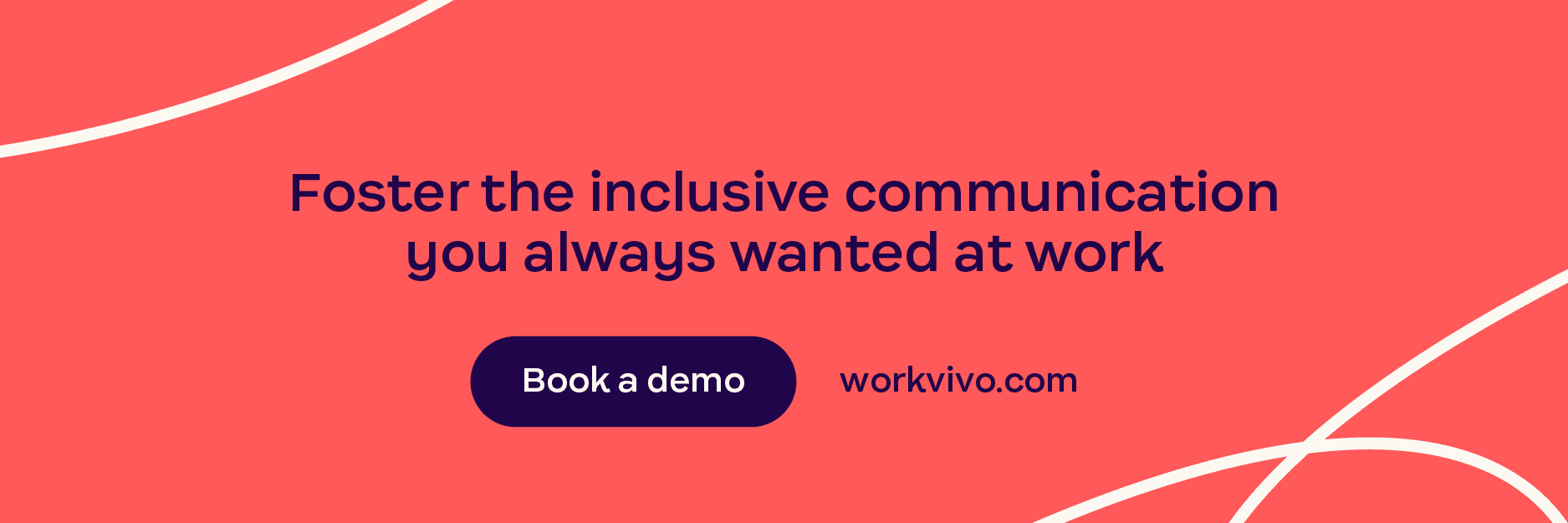Learn what 7,500+ frontline workers feel about culture, communication, and recognition
Inclusive Communication at Work: A Practical Guide

Chayanika Sen
Change Management & Internal Comms Professiona
November 4 2023

Want to learn how to create more inclusive communication at your workplace? This practical guide covers what inclusive communication is, why it matters, and strategies to improve it.
Workplaces are seeing more diversity each day, making inclusive communication more important than ever.
Yet research shows that 70% of employees don’t feel included at their workplace, and the majority of these workers are women, minorities, and junior staff.
This lack of inclusion, as it should, has consequences. Nearly 40% of respondents said they’ve turned down a job due to concerns about inclusion. Clearly, organizations have work to do to create truly inclusive cultures.
And in navigating this challenge, communication plays a central role. Inclusive communication ensures all employees, regardless of background or identity, feel welcomed, valued, and able to participate fully. When done right, it leads to greater innovation, collaboration, engagement, and a sense of belonging.
In this blog post, we’ll explore some best practices for fostering inclusive communication within an organization.
What is inclusive communication?
Inclusive communication in the workplace refers to communication practices that make all employees feel welcomed, valued, and able to participate fully. And it goes beyond just using respectful language. It considers how to meet the diverse needs of all workers.
Here are some key elements of inclusive communication:
- Being aware of different cultural communication styles and needs
- Providing accommodations like captions or sign language interpreters
- Using respectful, non-discriminatory language
- Actively listening and encouraging two-way dialogue
- Being open to different perspectives and ideas
Now, inclusion also means more than just having diversity within an organization. True inclusion is about creating an environment where everyone feels respected and appreciated and has equal opportunities to contribute meaningfully.
The words and communication style used at the workplace on a daily basis have a significant impact on whether employees feel included. If we look at it globally, there is still room for improvement when it comes to leaders adopting truly inclusive communication styles despite the emphasis on diversity and inclusion.
How does inclusive communication help companies?
Inclusive communication is not just the right thing to do for employees; it also provides tangible benefits for companies.
Organizations can enhance innovation, decision-making, productivity, and more by ensuring all voices are heard and valued.
Let’s explore how inclusive communication can give companies a competitive advantage.?
Fosters a diverse and inclusive workforce
Companies that work on inclusive communication attract and retain diverse talent more successfully.
Employees want to feel welcomed, respected, and able to fully participate. Policies are not enough; it’s daily communication practices that truly promote a sense of belonging.?
Salesforce is one example of a company that credits its commitment to inclusivity for its ability to build a global, diverse workforce. Through employee resource groups and training on inclusive language, they foster an environment where people of all backgrounds can thrive.
Enhances employee engagement and satisfaction
Research shows that inclusion is a major driver of employee engagement. Employees who feel their voices are heard and valued have greater job satisfaction.
High employee engagement also results in 17% more profitability, 41% fewer absences, and up to a 59% reduction in employee turnover.
Employees also say inclusion impacts their decision to stay at a company. Inclusive communication from leadership and direct managers is key to fostering this sense of belonging.
Drives innovation and creativity
Diverse teams have been shown to develop more innovative solutions – but only if they have inclusive communication practices. Employees must feel empowered to share unique perspectives and challenge assumptions.
Netflix is renowned for its innovative culture, which they attribute to “radical candor” in communication. By being open and non-judgemental, they create a space for creative thinking.
Improves decision-making and problem-solving
Research shows diverse teams make better decisions – again, provided they communicate inclusively. Multiple perspectives lead to more thoughtful analysis and mitigation of blind spots.
SAP increased minority representation in leadership roles and on decision-making teams. Combined with communication training, they were able to leverage diverse insights and improve strategic planning.
Enhances reputation and brand image
Companies known for inclusive communication develop reputations as progressive, ethical organizations. Consumers increasingly support brands that reflect their values around diversity.
Microsoft’s pro-diversity messaging and campaigns have positioned the tech giant as an industry leader in inclusion. This resonates powerfully with customers and recruits.
What can people leaders do to promote inclusive communication?
1. Raise awareness
People leaders need to spearhead campaigns that communicate the importance of inclusion to all staff. Messaging, training initiatives, and modeling set clear expectations for inclusive language and behaviors. Setting these standards prevents exclusionary communication from becoming normalized.
2. Understand the audience?=
People leaders must account for differences in communication styles and needs between groups. Communication varies based on roles, abilities, languages, and cultures. For example, some may require accommodations like captions or translators. Understanding the audience ensures all feel comfortable expressing themselves.
3. Highlight inclusive language
People leaders should proactively share guidelines that highlight inclusive verbal and written communication. Simple changes like using ‘people’ rather than genders or saying ‘uses a wheelchair’ rather than ‘wheelchair-bound’ demonstrate sensitivity.?
Ongoing guidance prevents exclusionary phrases that reinforce stereotypes. We’ll discuss more about language inclusivity in the next section.?
4. Involve the entire organization
Change starts from the top; leadership must model inclusive communication daily to set the tone. However, people leaders in HR and internal comms should engage all staff in building an inclusive culture. They can advocate for inclusive policies, training programs, ERGs, and accountability mechanisms to sustain progress. The goal is for inclusion to become ingrained in systems and culture.
When implemented correctly, these strategies empower employees to communicate openly without fear of judgment. HR and internal comms also play a critical role in fostering an environment where all voices are valued, but this requires purposeful, thoughtful effort across the entire organization. Inclusive communication unlocks the full potential of a diverse workforce.?
Tips to make language at the workplace more inclusive
Inclusive communication starts with being thoughtful about the words we use. Developing language guidelines can eliminate bias and create a more welcoming environment.
1. Inclusive language examples
Exclusive language often stems from outdated gender assumptions, like using ‘he’ as the default pronoun. Simple swaps can make communication more inclusive.?
Problematic term | Inclusive term |
Chairman | Chairperson |
Manpower | Workforce |
Ladies and gentlemen | Folks or everyone |
Normalizing gender-neutral language and sharing pronouns signals that people of all gender identities belong.
2. Substitutes for stereotypes and culturally respectful phrases
Many common idioms and phrases perpetuate negative stereotypes or inappropriately borrow from marginalized cultures. For example:
- Avoid ‘spirit animal’, which trivializes Native American spiritual beliefs. Use ‘patronus’ or ‘kindred spirit’ instead.
- Don’t use ‘peanut gallery’, which has racist roots referring to segregated theater seating. Say ‘hecklers’ or ‘jokesters’ instead.
- Don’t say ‘tribe’, which associates marginalized groups with savagery. Use ‘community’ or ‘group’ instead.
- Don’t say ‘blacklist’ or ‘whitelist’, which equates black with bad and white with good. Use ‘blocklist/denylist’ and ‘allowlist’ instead.
The safest option is to speak plainly. Idioms and metaphors often exclude those less familiar with the cultural context. Plain, direct language is more accessible.
3. Ableist language and person-first alternatives
Ableist language defines people solely by their disability or implies disabilities are abnormal. Person-first language puts the person before the disability. For example:
- Say ‘person with a disability’ rather than ‘disabled person’
- Say ‘uses a wheelchair’ rather than ‘wheelchair-bound’
However, some individuals prefer identity-first language as a way to reclaim their disability with pride. Always respect individual preferences. For example:
- Some embrace the term autistic rather than ‘person with autism’
- Many prefer Deaf rather than ‘hearing impaired’
The key is avoiding language that portrays disabilities as limitations or defects. Focus on the person first and ask about their preferred terminology.
7 Strategies for more inclusive communication at the workplace
1. Cultivate empathy through perspective-taking
Move beyond sympathy to truly imagining others’ experiences. Techniques like roleplaying with reversed statuses build understanding.
If leaders try wheelchair navigation or wearing sound-blocking headphones, they gain empathy. Anonymous sharing of microaggressions faced creates awareness.
These perspective-taking exercises in meetings bring new insights, which provide the mindset shift needed for inclusion.
2. Audit communication touchpoints
Look at all areas where communication occurs, from job postings to intranet messaging. Review for subtle exclusionary language. For example, using culture fit in hiring can perpetuate homogeny. Gendered terms in awards alienate non-binary staff.
Analyze metrics like demographics of who applies to positions. Continually evaluating communication touchpoints identifies gaps.
3. Give employees a voice
Provide formal mechanisms for marginalized groups to share concerns and input. Employee Resource Groups representing diverse communities should have executive advisement. Anonymous surveys allow open feedback. Suggestion boxes let anyone submit ideas comfortably. Take action on input to build trust. Giving a voice to those often unheard drives inclusion.
4. Make accommodations the default
Rather than waiting for requests, build in accommodations upfront. For example, enable closed captioning automatically in meetings. Send agendas in advance for those who need processing time. Offer plain language alternatives alongside complex text. Accommodations that benefit one group often help many. Universal inclusion takes the burden off marginalized employees.
5. Incentivize inclusive communication
Want sustainable change? Incentivize it. Recognize that modeling inclusion and call out exclusionary missteps respectfully. Build metrics on inclusive communication into performance systems. Highlight inclusion in employer branding to attract diverse talent. Employees prioritize what is valued. Positive reinforcement and celebration of wins drive culture.
6. Don’t assume one communication style fits all
Provide options to accommodate different needs and preferences. A Deaf employee may prefer written communication, while others want phone calls. Neurodiverse staff may take things literally. Those with social anxiety may avoid meetings. Ask rather than assume how people want to communicate and offer choices like transcripts, captions, agendas, etc. Surveying staff anonymously helps identify needs.
7. Provide ongoing inclusive communication training
One-time training is insufficient. Provide regular refresher courses explicitly focused on inclusive communication. Include case studies and interactive elements like sharing personal pronouns or filming practice scenarios. Build inclusion into formal development planning. Continual skills practice is essential for sustainable change.
On a concluding note…
Inclusive communication is crucial for workplaces seeking to thrive in today’s diverse industries. It goes beyond moral obligation; it’s a strategic advantage.
Organizations can attract diverse talent, boost engagement, and drive innovation by making all employees feel valued and heard and inclusive communication does that.
Inclusive communication fosters an environment where everyone can contribute their best, ultimately leading to greater success and a more harmonious workplace.
So, whether you’re an employee or a leader, embracing inclusive communication is a powerful step toward creating a workplace where all voices are valued, and everyone has an equal opportunity to grow.
